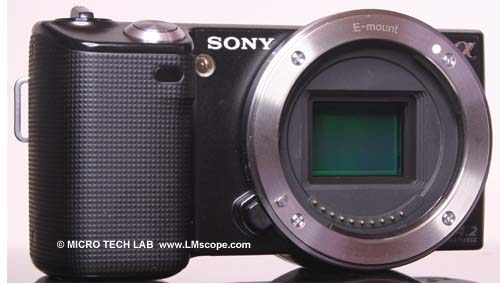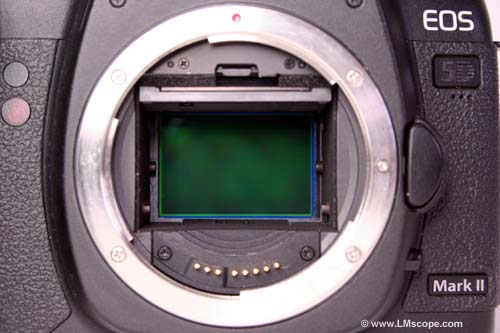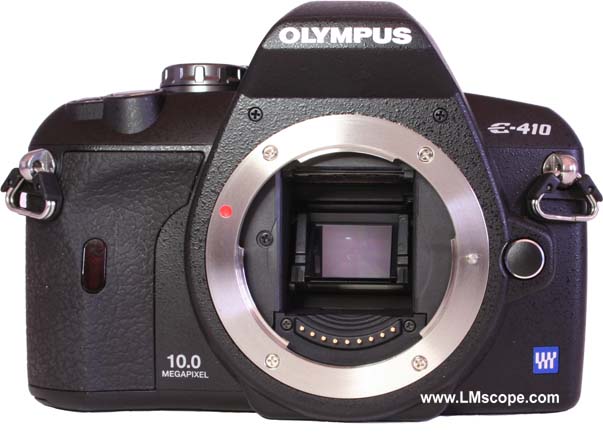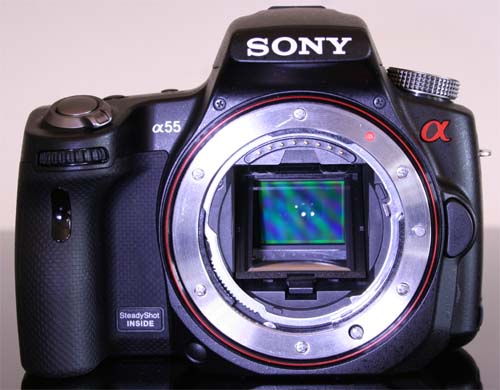

Vibrations inside the camera during the image capturing process
In microphotography, even minimal vibrations during the image capturing process will lead to a significant reduction in image quality. These motion blurs are mainly caused by the camera’s moving mirror and its mechanical shutter. Depending on the camera manufacturer and model, different systems are employed to avoid image-blurring vibrations to the maximum extent possible.
1.) Live View system cameras: Cameras with an interchangeable lens mount system and no mirror
This emerging class of system cameras (e.g. the Sony NEX series or the Olympus Pen series) is characterised by its mirrorless system. These cameras are designed without the rotating mirror shutter required for an optical viewfinder. Most mechanical vibrations during the shutter release sequence are caused by the mirror and the mechanical shutter, the latter of which controls the exposure time. At the beginning of the exposure process, the shutter closes and a digital reset sequence is initiated. Then, the shutter opens and the exposure process starts. Once the exposure time is complete, the shutter closes again for readout of the sensor data. During the readout process, the sensor must not receive any light. A Live View image appears only after the shutter opens again.
2.) Live View SLR cameras: Cameras with separate motors for the mirror and shutter
Depending on the camera model, different systems are employed to power the shutter mechanism and mirror assemblies independently. High-quality cameras (e.g. the Canon EOS 5D Mark II, Canon EOS 5D Mark III, Canon EOS 5D Mark IV, Nikon D7000, Nikon 7D, Nikon 4D, Canon EOS-1D X,...) are able to operate the shutter independently from the mirror. If an image is taken in Live View mode, the camera leaves its mirror flipped up. The shutter closes and a sensor reset takes place. At the beginning of the exposure sequence, the shutter opens again. It closes once the exposure is complete, after which the image data is offloaded. To display the image in Live View mode, the shutter opens once more.
During the whole process, the mirror itself is not moved at all and therefore does not cause any vibrations. As a result, features such as mirror lock-up or pre-release are no longer required while operating in Live View mode.
The only factor causing motion blurs is the mechanical shutter. However, due to its very light weight, the vibrations caused by the shutter are, in most cases, very insubstantial and have hardly any impact on the image quality. Modern prosumer cameras (e.g. the Canon EOS 5D Mark II, Canon EOS 5D Mark III, Canon EOS 5D Mark IV, Nikon D7000, Nikon 7D, Nikon 4D, Canon EOS-1D X,...) offer a solution even for this “residual risk”: the Canon EOS 5D Mark II, for example, is equipped with a mode that allows the photographer to disable the mechanical shutter at the beginning of the image capturing sequence so that the camera only performs a sensor reset. This system is called digital shutter release.
Some high-priced cameras (e.g. the Canon 7D, Canon 40D, Canon 60D or Canon 5 Mark II, Canon EOS 5D Mark III, Canon EOS 5D Mark IV, Nikon 4D, Canon EOS-1D X,...) are also equipped with special functions designed to produce virtually noiseless images (i.e. without any motion blurs). These various “noise reduction” settings offer a number of highly interesting features.
3.) Live View SLR cameras: Cameras with a single motor for the mirror and shutter
Lower priced SLR cameras generally do not have separate motors that drive the mirror and the shutter. If the shutter is operated in Live View mode, the mirror flips down and then up again. All this flipping shakes the camera and thus causes (sometimes significant) vibrations that may seriously compromise the image quality. To reduce the impact of mirror slap, most models come equipped with a special function called mirror lock-up (mirror pre-release). When the mirror lock-up function is enabled, the mirror is flipped up well before the shutter opens (a time interval between 2 and 8 seconds can be selected). This short pause allows the mirror-induced mechanical vibrations to die down before exposing the film so that they do not affect the image quality.
4.) Live View SLR cameras: Cameras with a translucent mirror
By foregoing a moving mirror and using a fixed translucent (= semi-transparent) mirror instead, no motion blurs occur. Because the mirror unit is translucent, it simultaneously reflects light to the camera sensor and the optical viewfinder. The translucent mirrors of the Sony Alpha series, for example, redirect the light in a fixed ratio: 80% to the sensor and 20% to the viewfinder. Sony is the first manufacturer to equip all of its Alpha camera models with the company’s translucent mirror design.
However, mechanical shutter sound is still present in the Alpha models, as it is in all system cameras.
Update: 01.07.2013
New LM Digital Adapter for: Nikon Z9 / Nikon Z8 / Sony Alpha 7R V / Sony Alpha 1 / Sony FX3 Cinema Line / Sony Alpha 9 II (ILCE-9M2) / Sony Alpha 9 / Nikon D6 / Canon EOS R3 / Canon EOS R6 Mark II / Canon EOS R8 / Sony Alpha 7R IV / Canon EOS R5 / Sony Alpha 7S II / Sony Alpha 7S III / Sony Alpha 7R III / Canon EOS R6 / Nikon Z6 / Nikon Z6II / Sony Alpha 7R II / Nikon Z7 / Nikon Z7II / Canon EOS R / Canon EOS Ra (Astro) / Nikon Z5 / Sony Alpha 7C / Canon EOS RP / Sony Alpha 7S / Canon EOS R7 / Leica SL2-S / Canon EOS R10 / Canon EOS 1D X Mark III / Nikon Z50 / Nikon Z30 / Nikon Z fc / Nikon D850 / Canon EOS 1D X Mark II / Nikon D780 / Olympus OM-1 / Sony Alpha 7III / Olympus OM-D E-M1 Mark III / Canon EOS R100 / Sony Alpha 6700 / Nikon D5 / Sony Alpha 6600 / Fujifilm X-H2S / Fujifilm X-S10 / Fujifilm X-E4 / Fujifilm X-Pro3 / Olympus OM-D E-M1X / Sony Alpha 6400 /



